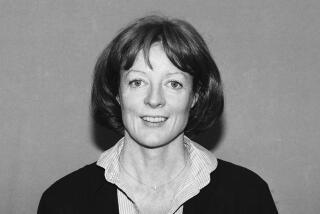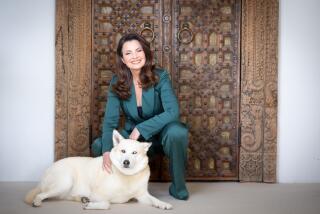Barbara Stanwyck Dies; Career Spanned 60 Years
Barbara Stanwyck, whose talent, blue eyes and pulsating voice made her a dominant presence during 60 years of stage, screen and television appearances, died Saturday of heart failure. She was 82.
Miss Stanwyck, whose career spanned the chorus line, vaudeville, movies, television and won her three Emmys and an honorary Oscar, had been admitted to St. John’s Hospital and Health Center in Santa Monica about a week ago.
“She died shortly before 5 p.m.,” said Larry Kleno, Miss Stanwyck’s longtime press agent. “It was congestive heart failure.”
Celebrities attending Saturday night’s Golden Globe awards were quick to praise Miss Stanwyck.
“It’s the passing of a great lady of the screen,” actress Angela Lansbury said. “I was very sorry to hear it.”
As a performer in 88 films, Miss Stanwyck emerged as one of the screen’s strong independent women. Like Katharine Hepburn, Bette Davis, Joan Crawford and other major stars from Hollywood’s so-called Golden Years, she had her own distinct style. The Barbara Stanwyck persona on films was often the femme fatale or the “good bad girl,” able to project simultaneously toughness and warmth, cynicism and sensitivity.
She was nominated four times for an Academy Award--for roles in “Stella Dallas,” “Double Indemnity,” “Ball of Fire” and “Sorry, Wrong Number,” and received an honorary Oscar in 1982 for her acting achievements.
Born Ruby Stevens on July 16, 1907, in Brooklyn, Barbara Stanwyck was an orphan who said she never knew her parents. The task of raising her fell to an unmarried sister, a chorus girl who boarded her with a series of families while she traveled with roadhouse musicals.
From early childhood, Miss Stanwyck wanted to become a dancer. She quit school at 13 to wrap packages in a Brooklyn store and taught herself to dance. Just after her 15th birthday, she got her first performing job--hanging from the ceiling as part of a living chandelier in a Ziegfeld Follies number.
A year later, in 1923, she became a chorus girl in a New York musical review. After dancing in lots of chorus lines in lots of shows, she tried out for a part in a production put together by Willard Mack, a top producer and director of the day. This was to transform her from dancer to actress, the kind of break all would-be stars usually can only dream about.
Mack had a part for a chorus girl in his new play, “The Noose,” but the job was only available in the play’s out-of-town tryout in Philadelphia. For its Broadway run, the part had already been cast.
After this, “destiny stepped in,” Miss Stanwyck later said. The play was about a man condemned to death who loved a society woman and cared nothing for the little chorus girl who loved him. But the original third act, where the society woman pleaded with the warden for the body of the condemned man so she could bury him, didn’t go over with the out-of-town audience. “So the play was rewritten to give the scene to the chorus girl,” Miss Stanwyck recalled. “That meant I had to carry the third act.”
Mack started rehearsing with her day and night. “He saw something in me,” Miss Stanwyck said in an interview years later. “I was a dancer, not a great one, but I knew left from right. But I was no actress. . . . He taught me how to walk, taught me nuances, taught me tricks.”
Mack also changed her name. Declaring Ruby Stevens was no name for a star, he scanned names on several playbills hanging nearby and came up with Barbara Stanwyck.
When the play returned from Philadelphia in 1925, Miss Stanwyck not only replaced the girl who was to have the part in New York, but the now long-forgotten play proved a hit and ran on Broadway for nearly a year.
On the strength of that and other theatrical successes, she made her screen debut in a silent film, “Broadway Nights,” shot in New York in 1927, and went back to Broadway in 1928. The same year, she married vaudevillian Frank Fay, and then followed him to Hollywood where he had signed a screen contract. There they adopted a son, Anthony Dion Fay.
While Mack established her on stage, it was director Frank Capra who provided her shot to movie stardom. This happened after her first two Hollywood films, “The Locked Door” and “Mexicali Rose,” both in 1929, bombed, and her movie career seemed headed for disaster.
But Capra signed her for “Ladies of Leisure,” reportedly without a screen test. She played an artist’s model of easy virtue who unintentionally falls in love with a wealthy young artist.
Capra, she later said, taught her about using her eyes. “These are the greatest tools in film,” she said in an interview, pointing at them: “It’s nice to say very good dialogue, if you can get it. But great movie acting . . . watch the eyes.”
She gave herself credit for her throaty voice: “I had it from the beginning, God save me!” Film historian James Harvey once described it as suggestive of “not whiskey or disillusionment or sexual provocation as much as . . . the quite unsentimental sound of tears.”
Her walk, which was distinctive for its authoritative, unhesitant stride, she credited to producer David Belasco and a certain animal at the zoo. Belasco, she said, once remarked that women do not know how to walk, and advised if she wanted to learn she should “go to the zoo. Watch animals walk.” She took his advice, and said she copied the panther’s stride.
“Ladies of Leisure” was followed by four other Capra-directed films, and she became a favorite of such major directors as Howard Hawks, Billy Wilder, King Vidor and John Ford. Cecil B. DeMille wrote in his autobiography: “I have never worked with an actress who was more cooperative, less temperamental and a better workman.”
Throughout her career, she was known as a disciplined, hard-working actress who came to the set with every detail of her characterization in place. Wilder once claimed Miss Stanwyck not only knew every line of her own dialogue but all the other actors’ dialogue too.
By the late 1930s she was solidly entrenched as one of Hollywood’s leading ladies, and became identified with roles portraying the tough, independent, hard-as-nails dame. One of these, the 1937 “Stella Dallas,” won her her first nomination for an Academy Award, playing an uneducated but ambitious woman who gives up contact with the one person she loves--her daughter--so that the young woman could have social position and a “good” life.
In the early 1940s she reached a career peak with films such as “The Lady Eve,” “Meet John Doe” and “Double Indemnity.” The latter, a 1944 film co-starring Fred MacMurray, brought her particular acclaim as a woman scheming to kill her husband.
Also in 1944, Miss Stanwyck’s name headed an Internal Revenue Service list of the highest-salaried women in the United States.
According to film biographers, her career faltered in the 1950s. Although she acted in more than 20 films during that decade--several of them Westerns--critics considered many of them second-rate. But her career rebounded on television in the 1960s, when she played the stern matriarch of the Barkley clan in the series “The Big Valley” from 1965 to 1969. She also starred in the 1983 miniseries “The Thorn Birds” and appeared for one season (1985-86) as Constance Colby in “The Colbys,” the prime-time melodrama.
She married twice. She divorced Fay in 1935 and married actor Robert Taylor in 1939. She starred with Taylor in “His Brother’s Wife” and “This Is My Affair,” in 1936 and 1937, and in “Night Walker” in 1965.
One of Hollywood’s best-known couples, she and Taylor divorced in 1952. An intensely private person, Miss Stanwyck rarely discussed this publicly. But in one interview, after talking about the difficulty of sustaining two careers in one marriage, she suddenly said: “Bob was bored. It took me a long time to accept that. To understand it. He said he wanted to be a married bachelor. . . . The pain followed. But it comes with the territory.”
When she was honored with the American Film Institute’s Life Achievement Award in 1987, a reporter asked if she was satisfied with what she had accomplished.
“It’s not . . . satisfaction exactly,” she answered. “Let’s say I did what I was supposed to do. I did my work.”
More to Read
Only good movies
Get the Indie Focus newsletter, Mark Olsen's weekly guide to the world of cinema.
You may occasionally receive promotional content from the Los Angeles Times.










